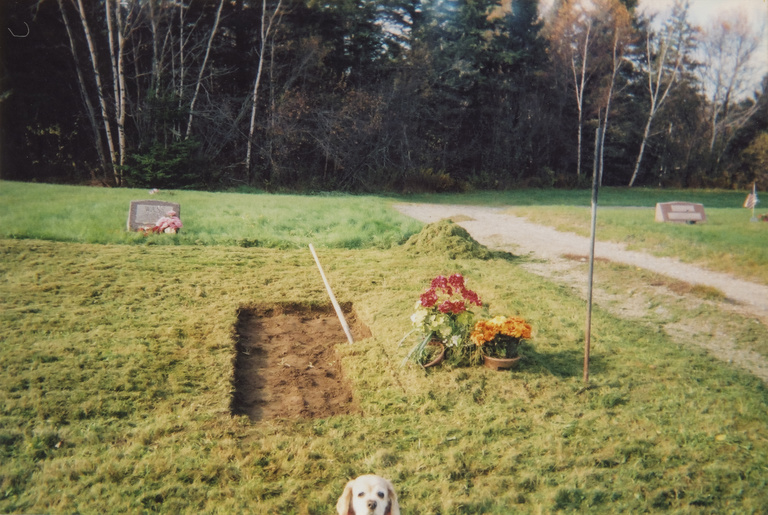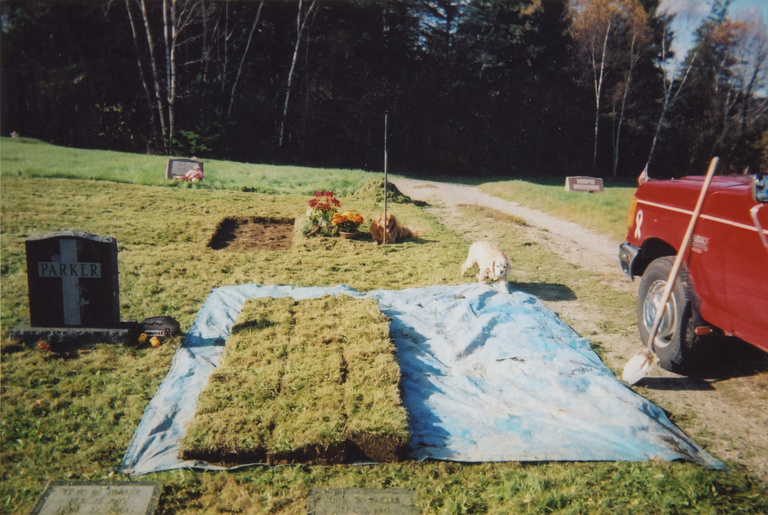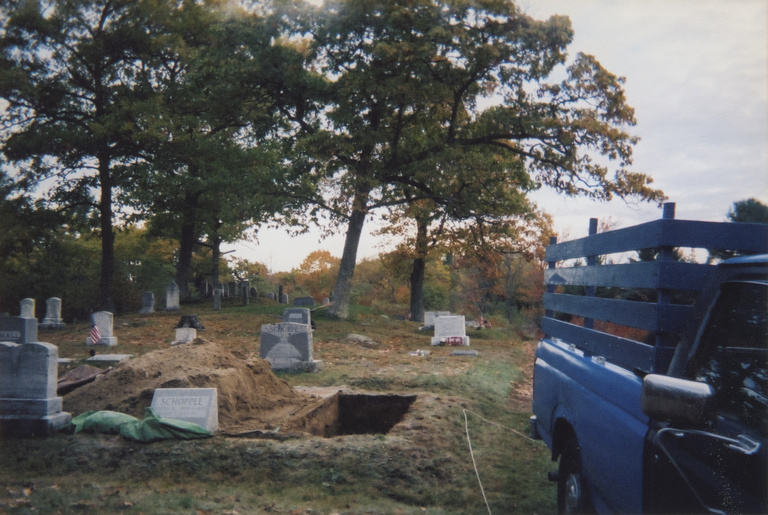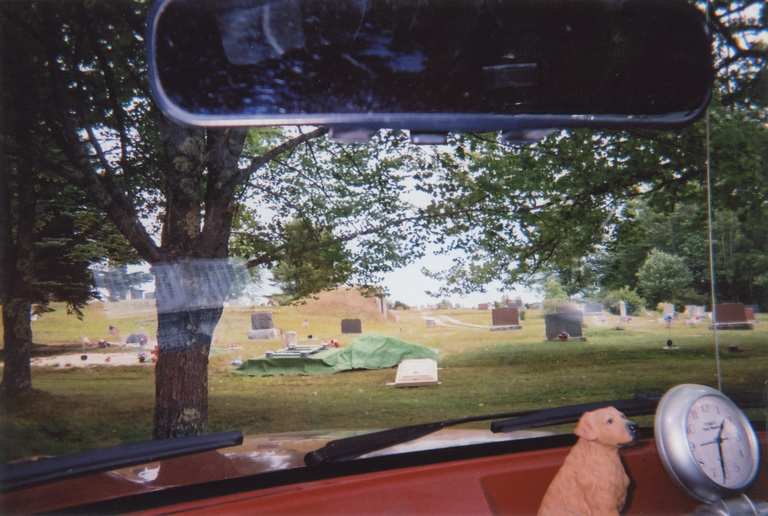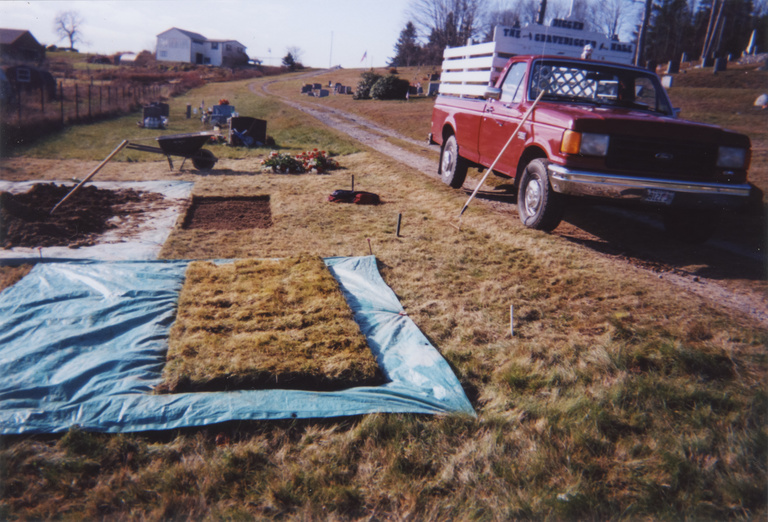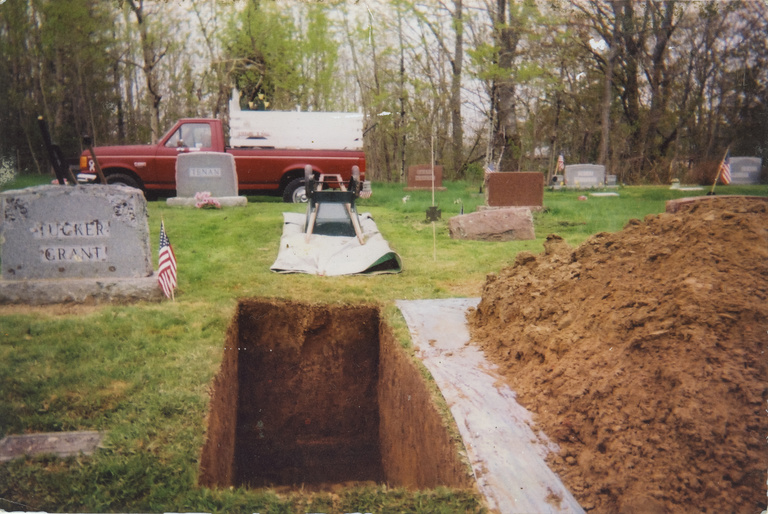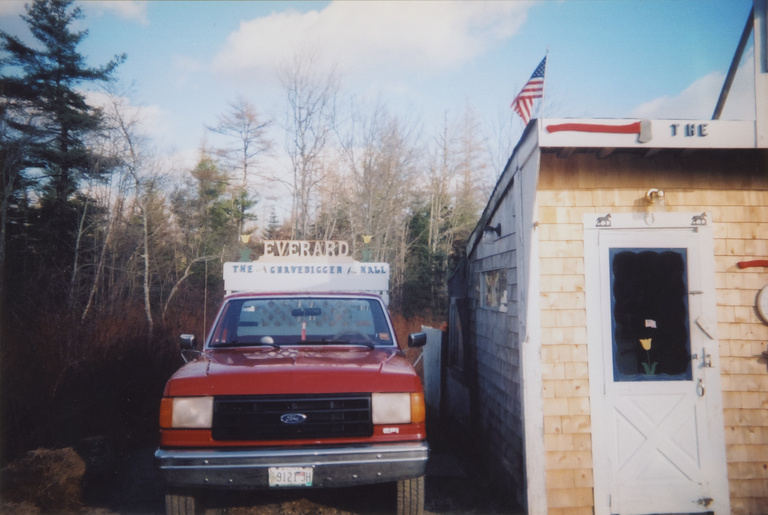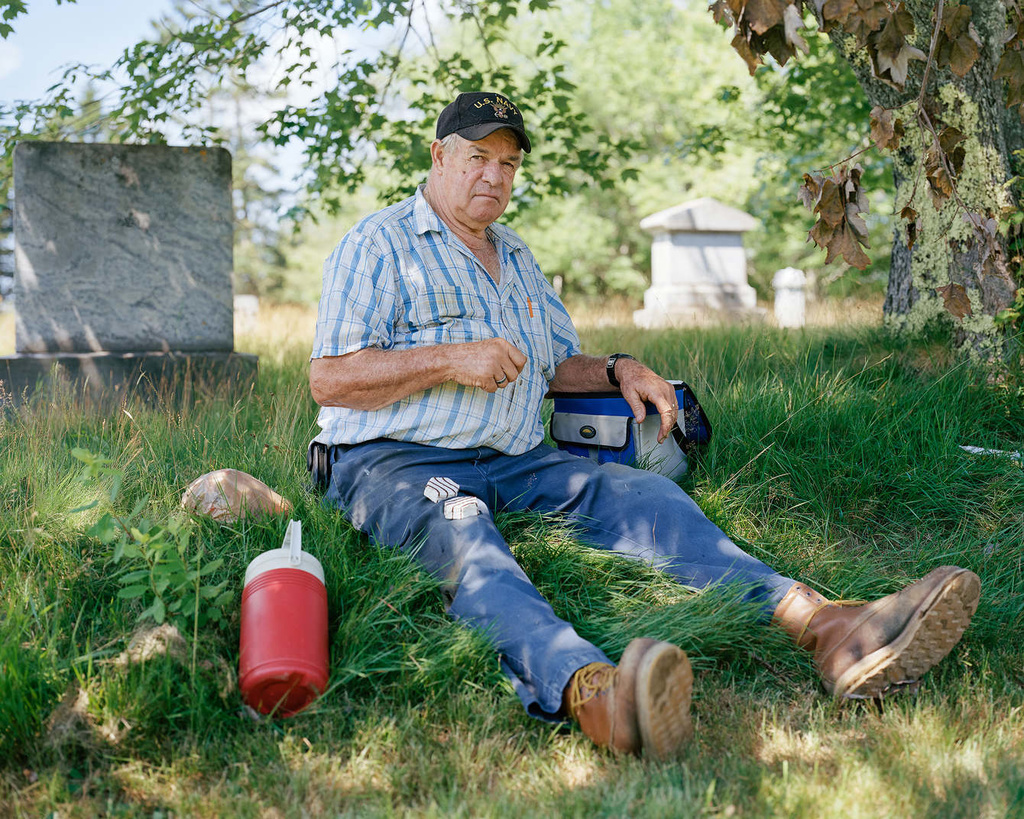
Who’s your local gravedigger? Do you know? Do you have one?
The residents of Cherryfield, Maine, do—and it’s not the dirty, shadow-clad figure you’re picturing. It’s local resident Everard Hall, smiling and ball-capped in a plaid work shirt. There’s a harmonica in his pocket and dancing boots in his pickup. Everard (pronounced “EVer-ard”) is one of the few remaining gravediggers in the U.S. who dig by hand—and he does it year-round across northeastern Maine. Using picks, shovels, chains, and winches to haul out rocks, ice, hardpan, roots, clay, and sand, he insists on doing the job with care and precision. It’s not surprising that UI photography professor Thalassa Raasch feels the exact same way about documenting Everard’s work. Her in-progress collection of photos and essays, In Over My Head, documents the unexpected beauty of Everard’s work as a gravedigger and explores the profound thresholds between solitude and community, life and death.
From the moment she read about him in a local newspaper, Raasch (Art & Art History, CLAS) knew she had to collaborate with Everard on a project. “I thought he sounded really interesting,” she recalls, “so I called him and said, ‘I want to come see what you’re doing and make some photographs.’” Everard invited her—then a student in Portland, Maine—to join him in a cemetery the very next day, where he was filling in a grave. “I had no idea at the time that it’d become kind of an obsession and fascination for me,” Raasch smiles.
That first day, Everard showed her his prized photo albums filled with pictures (his own) of the 2,500 graves he’d dug over the course of 49 years, including those of his parents, his siblings, his neighbors, and his grade-school teachers. Page after page of perfect black rectangles in snow-covered ground, sod squares laid out in rows, and finished gravesites complete with flowers and memorial decorations. “My jaw was on the floor,” remembers Raasch. “I’d never seen anything like it.” What was this compulsive urge to document each grave? As a professional photographer, Raasch also noticed an artistic mentality at work in many of Everard’s photos—in the way he’d composed a certain image, taken into account the opacity of a shadow or the angle of a shovel. He struck her as an artist both in the way he created a grave and in the way he photographed it.
On "making" vs. "taking" photographs
Raasch, like many professional photographers, prefers the phrase “making a photograph,” as it conveys the deliberate agency involved in crafting a photo. Both in her practice and in her teaching, she endeavors “to move away from the possessive and aggressive language of photography ("take," "load," "aim," "shoot") toward a language of creation.”
Raasch and Everard gradually built a friendship, and Raasch continued to visit him once or twice per year. One summer, she actually lived and worked with him in Cherryfield: “It was a sort of apprenticeship, where I labored alongside Everard digging and making photographs and grieving, all while doing my best to keep up with his exacting methods.” She was surprised to find that he shared memories about the deceased as he worked. Even if he didn’t know them personally, she says, “he’d be talking about the person, stories he’d heard or read about them, trying to build a picture of who they were.” He was, she saw, “grieving by association,” bearing witness to their lives. And long after he filled a grave, he would regularly return to that cemetery to seed grass, level the ground, and remember the person. This was something he did via his photography, too—except that his pictures bear witness both to the people he’s buried and to the work of the community gravedigger.

It's this community aspect that’s especially remarkable. A community needs a gravedigger, of course, and a gravedigger needs a community—their support, that is, and their acceptance. Unlike so many laborers throughout history who were shunned for digging graves, Everard belongs to his community. “Being their gravedigger is deeply important to who he is, his way of being in the community and in the world,” reflects Raasch, pointing to a photo of his pickup truck, bedecked with crosses and a sign proclaiming, “The Gravedigger Hall, Country Boy.” Nearly everyone in the small community recognizes the truck, knows Everard, rubs elbows with him at country dances, stop him in the grocery store to chat—even joke—about the gravedigging business.
“I was struck by how almost mundane it was, the way people would just talk to him about digging their grave or digging other people’s graves, and it was just part of life,” says Raasch. “Actually, I found it comforting. It’s a very modern thing to feel like burial is spooky or uncomfortable. Not too long ago, preparing bodies for burial was a very normal part of life.” Indeed, as cultural historians point out, American attitudes toward death shifted radically during the early twentieth century, effectively segregating the dying and the dead from the living. Cemeteries—or nearly maintenance-free “memorial parks”—began to look the same: featureless, flat, depersonalized. And as for gravedigging—well, the word itself became nearly unspeakable. (For more about this, see Charles Jackson’s “American Attitudes to Death.”)
Raasch spent three years watching Everard quietly restore death’s visibility through his rituals of care. Ultimately she decided to publish a book of his photos alongside her own: “I thought of it as an ‘image dialogue,’” she says, with her photos filling in the gaps. For instance, Everard rarely photographs his tools or himself, but Raasch has made striking photos of both. She recently workshopped her manuscript with five senior scholar-artists during an Obermann/OVPR Book Ends session. “That conversation really lit a fire,” she says. “It was exactly what I needed—a little buoy to the next step.” She admits that she has a lot of revising to do—particularly to build out the essay portion of the book, to weave in more of her own experiences with Everard—but it’s an opportunity she’s excited about. “At first I was trying to keep the introduction short and sweet and get out of the way of the images.” But now she’s planning to reshape the book into a more focused, more intimate portrait of her and Everard’s time together. The new manuscript might include, for instance, her discussions with Everard while she was mourning the loss of her own beloved grandmother, when “I started looking to him in different ways to guide me through the grieving process.” The book will also make space for critical reflection on the formal and metaphorical parallels between gravesites and photographs.
The Book Ends workshop didn’t just help Raasch rethink her manuscript, though; it surrounded her with sorely needed community. Having joined the UI faculty in 2021, mid-pandemic, she’d felt isolated, particularly at work. “But at the Book Ends review, I had a room of folks having a critical conversation about my work! It’s given me a chance to strengthen existing networks and meet new people at Iowa that I wouldn’t have otherwise encountered. I feel grounded here now, and it’s thrilling to feel like I have people on my team who want to see this project forward.”
In January, she’ll exhibit selected photos from In Over My Head at Washington University’s Weitman Gallery, in deep pine frames she’s made herself. The exhibition will feature audio and video recordings from her time with Everard. She foresees an audio landscape that brings the listener graveside with Everard as he shares a memory, his shovel works the dirt, and time gently passes. “His voice is so full of character, and he tells these terrific stories.”
Raasch has no official publication deadline, but (like all of us) she feels the pressure of time. Since she began this project, Everard has retired and his original photo albums have been destroyed by water. “So in the same way that he’s been doing this kind of caretaking for his community and carrying that weight, I’m in this position of caretaker of his archive and the evidence of his work,” she says, eager to realize her projects while he can appreciate them. Readers, too, are waiting—to join Everard and Raasch in the bearing of witness.
More:
- "Gravedigger at Work" — CBS Sunday Morning video segment (2016)
- "An old-school gravedigger plies his trade" — CBS News article (2016)
- "Everard Hall, gravedigger" — Bangor Daily News video interview (2020)
All photos below are from the archive of Everard Hall.
